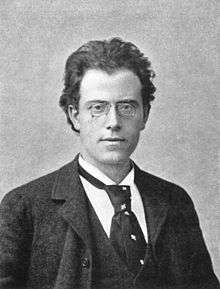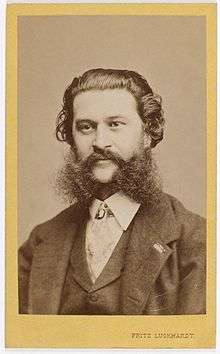List of Austrian composers
This is an alphabetical list of Austrian composers.
This is a dynamic list and may never be able to satisfy particular standards for completeness. You can help by expanding it with reliably sourced entries.
The portraits at right are seven of the most-prominent Austrian composers, as agreed by three published reviews.[1][2][3]
A - M
- Johann Georg Albrechtsberger (1736–1809) – Classical-era composer of preludes, fugues and sonatas for the piano
- Elkan Bauer (1852–1942) – 20th-century composer; wrote popular waltzes
- Alban Berg (1885–1935) – 20th-century composer; member of the Second Viennese School
- Anton Bruckner (1824–1896) – composer of nine large-scale symphonies, sacred works and organ works; church organist
- Antonio Casimir Cartellieri (1772–1807)
- Franz Clement (1780–1842), full name Franz Joseph Clement
- Carl Czerny (1791–1857) – composer; teacher of Ludwig van Beethoven; known for his piano exercises and pedagogy
- Anton Diabelli (1781–1858), also Antonio
- Carl Ditters von Dittersdorf (1739–1799) – Classical-era composer and violinist
- Anton Eberl (1765–1807)
- Joseph Leopold Eybler (1765–1846)
- Robert Fuchs (1847–1927)
- Johann Fux (1660–1741) – composer, influential theorist on Renaissance counterpoint
- Heinz Karl Gruber (born 1943) – composer, bassist and singer
- Siegmund von Hausegger (1872–1948)
- Georg Friedrich Haas – (b. 1953) Composer of contemporary classical music
- Joseph Haydn (1732–1809) – Classical-era composer; composed 104 symphonies, as well as numerous string quartets and other chamber music, operas and sacred works
- Michael Haydn (1737–1806) – Classical-era composer; younger brother of Joseph Haydn
- Leopold Hoffman (1738–1793) – Classical-era composer
- Johann Nepomuk Hummel (1778–1837) – composer and pianist; music bridged the Classical and Romantic periods
- Charles Kálmán[4] (1929–2015); also Charles Kalman
- Fritz Kreisler (1875–1962) – 20th-century violinist and composer
- Josef Labor (1842–1924)
- August Lanner (1835–1855), born Augustin Lanner
- Joseph Franz Karl Lanner (1801–1843) – early-Romantic-era dance-music composer; one-time colleague of Johann Strauss I
- Bruno Liberda (born 1953) – composer; student of Roman Haubenstock-Ramati; contemporary classical music; first electronic music ever to be performed in the Vienna State Opera
- Gustav Mahler (1860–1911) – late-Romantic composer of large-scale and sometimes programmatic symphonies; born in Bohemia in a German-speaking community, a subject of the Habsburg Empire; music director in Vienna in the 1890s and 1900s
- Jacques de Menasce (1905–1960) became an American in 1941
- Franz Xaver Wolfgang Mozart (1791–1844) – son of Wolfgang Amadeus Mozart
- Leopold Mozart (1719–1787) – Classical-era composer, violinist, author of influential treatise on playing the violin
- Wolfgang Amadeus Mozart (1756–1791) – composer of operas, piano concertos, chamber music, symphonies and sacred works; son of Leopold Mozart
N - Z
- Sigismund von Neukomm (1778–1858) – born Sigismond Neukomm, after ennoblement as a knight Sigismund Ritter von Neukomm
- Karl von Ordóñez (1734–1786) – also Carlo or Carl d'Ordonetz, Ordonnetz, d'Ordóñez, d'Ordonez, Ordoniz
- Kurt Overhoff (1902–1986) – composer and conductor
- Leonhard Päminger (1495–1567) – also Paminger and Panninger
- Maria Theresa von Paradis (1759–1824) – Classical-era composer; inspiration for the Piano Concerto No. 18 in B-flat major by Wolfgang Amadeus Mozart
- Walter Rabl (1873–1940) – Viennese composer, conductor and teacher of vocal music
- Carl Georg Reutter (1708–1772) – Baroque-era court composer
- Emil von Reznicek (1860–1945) – born Emil Nikolaus Joseph, Freiherr von Reznicek
- Franz Xaver Richter (1709–1789) – Czech František, French François Xavier
- Johann Heinrich Schmelzer (1623–1680) – composer and violinist; first German-speaking composer to publish solo violin and b.c. sonatas in the Italian style (Sonatae unarum fidium seu a violino solo, 1664)
- Franz Schmidt (1874–1939) – 20th-century composer of symphonies and operas, cellist and pianist
- Arnold Schoenberg (1874–1951) – 20th-century modernist composer; founder of the Second Viennese School; developer of the twelve-tone technique
- Franz Schubert (1797–1828) – Classical-/Romantic-era composer; regarded as the first significant lieder writer; composer of many instrumental works as well
- Robert Stolz (1880–1975) – conductor and composer of operettas, film music and songs
- Eduard Strauss (1835–1916) – dance-music composer; brother of Johann Strauss II
- Johann Strauss I (1804–1849) – early-Romantic-era dance-music composer
- Johann Strauss II (1825–1899) – Romantic-era composer of waltzes and polkas, wrote The Blue Danube waltz
- Josef Strauss (1827–1870) – dance-music composer; brother of Johann Strauss II
- Franz von Suppé (1819–1895) – Composer of light opera
- Franz Xaver Süssmayr (1766–1803) – Classical-era composer; student of Wolfgang Amadeus Mozart
- Sigismond Thalberg (1812–1871)
- Joseph Umstatt (1711–1762)
- Johann Joseph Vilsmayr (1663–1722)
- Georg Christoph Wagenseil (1715–1777) – Classical-era composer, harpsichordist, and organist
- Anton Webern (1883–1945) – 20th-century composer, member of the Second Viennese School; used the twelve-tone technique in addition to the style known as serialism
- Egon Joseph Wellesz (1885–1974) – 20th-century composer, teacher, musicologist; pupil of Arnold Schoenberg and student of Byzantine music
- Erich Zeisl (1905–1959) – Modernist Jewish Viennese composer of symphonies, ballets, choral music, operas, and film scores; fled Nazis for America in 1938
- Karl Michael Ziehrer (1843–1922), also spelled as Carl
References
- ↑ Moldafsky, Annie (10 February 1985). "Savoring Vienna: Music is everywhere". The Milwaukee Journal.
- ↑ Intercultural Outreach CultureGuides: Austria (PDF). Brigham Young University. 2006.
- ↑ Mariani, John (12 January 2015). "Vienna Is One of the Most Civilized Cities in Europe". Huffington Post.
- ↑ Charles Kálmán bio in German.
See also
This article is issued from Wikipedia - version of the 7/10/2016. The text is available under the Creative Commons Attribution/Share Alike but additional terms may apply for the media files.






